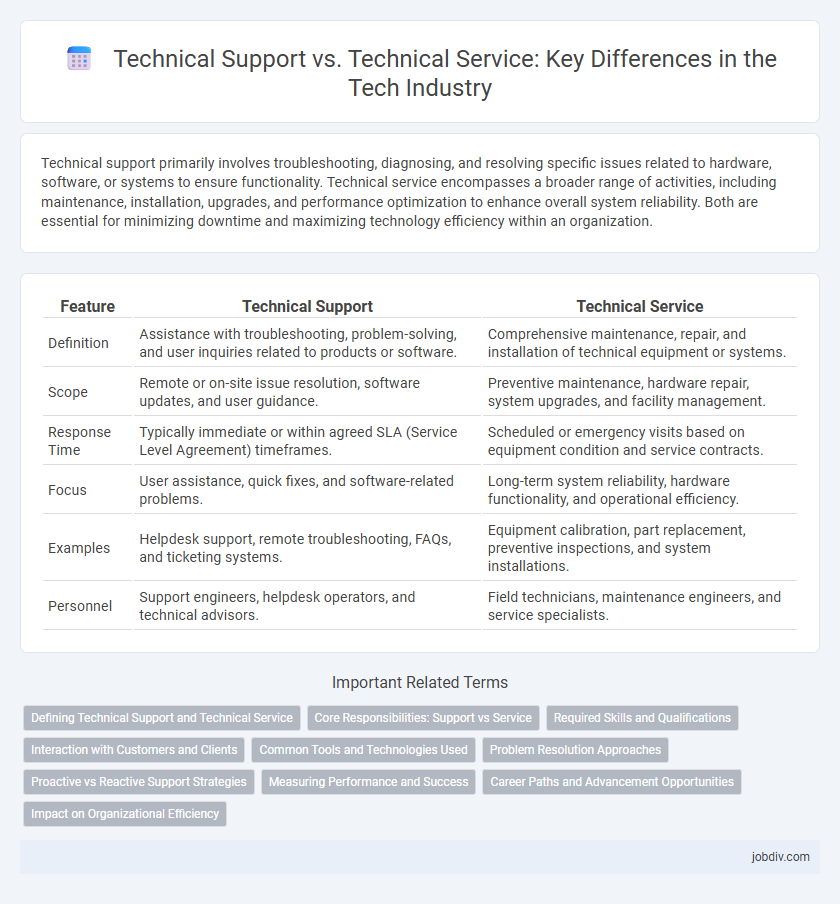Technical support primarily involves troubleshooting, diagnosing, and resolving specific issues related to hardware, software, or systems to ensure functionality. Technical service encompasses a broader range of activities, including maintenance, installation, upgrades, and performance optimization to enhance overall system reliability. Both are essential for minimizing downtime and maximizing technology efficiency within an organization.
Table of Comparison
| Feature | Technical Support | Technical Service |
|---|---|---|
| Definition | Assistance with troubleshooting, problem-solving, and user inquiries related to products or software. | Comprehensive maintenance, repair, and installation of technical equipment or systems. |
| Scope | Remote or on-site issue resolution, software updates, and user guidance. | Preventive maintenance, hardware repair, system upgrades, and facility management. |
| Response Time | Typically immediate or within agreed SLA (Service Level Agreement) timeframes. | Scheduled or emergency visits based on equipment condition and service contracts. |
| Focus | User assistance, quick fixes, and software-related problems. | Long-term system reliability, hardware functionality, and operational efficiency. |
| Examples | Helpdesk support, remote troubleshooting, FAQs, and ticketing systems. | Equipment calibration, part replacement, preventive inspections, and system installations. |
| Personnel | Support engineers, helpdesk operators, and technical advisors. | Field technicians, maintenance engineers, and service specialists. |
Defining Technical Support and Technical Service
Technical Support involves assisting users in troubleshooting, resolving technical issues, and providing guidance on software or hardware products. Technical Service encompasses a broader scope, including maintenance, installation, repair, and system upgrades to ensure optimal performance and longevity of technical equipment. Both functions aim to enhance user experience but differ in reactive support versus proactive system management.
Core Responsibilities: Support vs Service
Technical Support primarily focuses on troubleshooting, problem resolution, and assisting users with hardware or software issues to ensure operational continuity. Technical Service encompasses preventive maintenance, system upgrades, and performance optimization designed to enhance and sustain the overall functionality of technology infrastructure. Core responsibilities of support involve reactive interventions, while technical service emphasizes proactive management and lifecycle maintenance.
Required Skills and Qualifications
Technical support requires strong troubleshooting abilities, customer communication skills, and proficiency with software and hardware diagnostics, while technical service demands in-depth knowledge of system installation, maintenance, and repair procedures. Both roles commonly require certifications such as CompTIA A+, Microsoft Certified Professional, or vendor-specific credentials to validate expertise. Effective technical support specialists excel in problem-solving and remote assistance, whereas technical service technicians must demonstrate hands-on skills and familiarity with technical schematics and tools.
Interaction with Customers and Clients
Technical support involves direct interaction with customers to resolve specific issues through troubleshooting, guiding users, and providing real-time problem-solving assistance. Technical service encompasses broader customer engagement, including installation, maintenance, training, and preventive measures to ensure system functionality and satisfaction. Effective communication in technical support is reactive and problem-focused, while technical service emphasizes proactive relationship building and long-term client collaboration.
Common Tools and Technologies Used
Technical support and technical service commonly utilize tools such as remote desktop software, ticketing systems, and diagnostic applications to streamline issue resolution and service management. Technologies including network monitoring platforms, knowledge bases, and automated chatbots enhance both real-time troubleshooting and long-term technical maintenance. Integration of cloud-based solutions and AI-powered analytics further optimizes operational efficiency and customer satisfaction in technical support and service environments.
Problem Resolution Approaches
Technical support primarily focuses on resolving immediate issues by providing real-time troubleshooting, diagnostics, and guidance to end-users. Technical service encompasses a broader scope, including preventive maintenance, system updates, and long-term problem management to enhance overall system performance. Effective problem resolution approaches integrate both reactive support and proactive service strategies to minimize downtime and optimize technology lifecycle.
Proactive vs Reactive Support Strategies
Technical support primarily involves reactive strategies aimed at resolving user issues after they occur, focusing on troubleshooting and incident management. In contrast, technical service emphasizes proactive support, including system monitoring, preventive maintenance, and predictive analytics to identify and mitigate potential problems before they impact operations. Implementing proactive support strategies enhances system reliability, reduces downtime, and improves overall customer satisfaction by addressing issues early in the lifecycle.
Measuring Performance and Success
Measuring performance in technical support involves tracking metrics such as first response time, resolution rate, and customer satisfaction scores to ensure effective issue resolution. Technical service performance focuses on uptime, system reliability, and preventive maintenance effectiveness to maximize operational continuity. Success in both areas depends on aligning key performance indicators with business objectives and continuously analyzing data for process improvements.
Career Paths and Advancement Opportunities
Technical support roles primarily focus on resolving client issues with hardware, software, or systems, offering a foundation for careers in IT helpdesk and system administration. Technical service careers often encompass broader responsibilities such as system implementation, maintenance, and performance optimization, providing pathways into network engineering or IT management positions. Advancement opportunities in technical service typically require deeper technical expertise and project management skills, whereas technical support roles emphasize customer service and troubleshooting proficiency.
Impact on Organizational Efficiency
Technical support addresses immediate user issues and troubleshooting, ensuring minimal downtime and maintaining workflow continuity. Technical service involves proactive maintenance and system upgrades, enhancing overall infrastructure reliability and preventing future failures. Together, these functions optimize organizational efficiency by reducing disruptions and extending the lifecycle of technological assets.
Technical Support vs Technical Service Infographic

 jobdiv.com
jobdiv.com